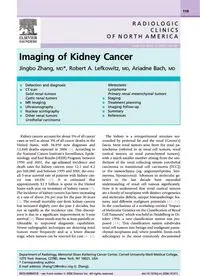
06 - Radiol Clin N Am 2007 - Imaging of Kidney Cancer PDF
Preview 06 - Radiol Clin N Am 2007 - Imaging of Kidney Cancer
Imaging of Kidney Cancer Jingbo Zhang, MD*, Robert A. Lefkowitz, MD, Ariadne Bach, MD Kidney cancers account for about 3% of all cancer cases as well as about 3% of all cancer deaths in the United States, with 38,890 new diagnoses and 12,840 deaths expected in 2006 [1]. According to the National Cancer Institute’s Surveillance, Epide- miology, and End Results (SEER) Program, between 1998 and 2002, the age-adjusted incidence and death rates for kidney cancers were 12.1 and 4.2 per 100,000, and between 1995 and 2001, the over- all 5-year survival rate of patients with kidney can- cer was 64.6% [2]. It is estimated that approximately $1.9 billion is spent in the United States each year on treatment of kidney cancer [3]. The incidence of kidney cancers has been increasing at a rate of about 2% per year for the past 30 years [2]. The overall mortality rate from kidney cancers has increased slightly over the past 2 decades, but not as rapidly as the incidence rate. This discrep- ancy is due to a significant improvement in 5-year survival [4]. These trends may be at least partially at- tributable to improved diagnostic capabilities. Newer radiographic techniques are detecting renal tumors more frequently and at a lower disease stage, when tumors can be resected for cure [5–11]. The kidney is a retroperitoneal structure sur- rounded by perirenal fat and the renal (Gerota’s) fascia. Most renal tumors arise from the renal pa- renchyma (referred to as renal cell tumors, renal cortical tumors, or renal parenchymal tumors), with a much smaller number arising from the uro- thelium of the renal collecting system (urothelial carcinoma or transitional cell carcinoma [TCC]) or the mesenchyma (eg, angiomyolipoma, leio- myoma, liposarcoma). Advances in molecular ge- netics in the last decade have expanded understanding of renal cell tumors significantly. Now it is understood that renal cortical tumors are a family of neoplasms with distinct cytogenetics and molecular defects, unique histopathologic fea- tures, and different malignant potentials [12–16]. In the conclusions of a workshop entitled ‘‘Impact of Molecular Genetics on the Classification of Renal Cell Tumours,’’ which was held in Heidelberg in Oc- tober 1996, a new classification system was pro- posed [14]. This classification system subdivides renal cell tumors into benign and malignant paren- chymal neoplasms and, where possible, limits each subcategory to the most commonly documented R A D I O L O G I C C L I N I C S O F N O R T H A M E R I C A Radiol Clin N Am 45 (2007) 119–147 Department of Radiology, Memorial Sloan-Kettering Cancer Center, Cornell University Weill Medical College, 1275 York Avenue, C278D, New York, NY 10021, USA * Corresponding author. E-mail address:
